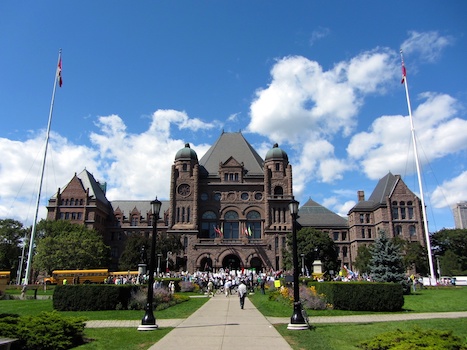Reckoning with rigs

Every day, thousands of heavy trucks carrying freight, logs, or dangerous substances weave their way through the heart of downtown Ottawa, squeezing past shops, homes, a daycare, and places of worship.
Ottawa’s truck problem began more than 50 years ago, in 1967, when the Macdonald-Cartier interprovincial bridge was constructed. The adjacent King Edward Avenue, which slices through two of the city’s most historic neighbourhoods, became a major truck route, carrying transport trailers and other big rigs between western Quebec and eastern Ontario.
Last month, a group of Ontario physicians called for an investigation into the polluted trucking corridor, citing concerns about its impact on public health.
“We know the health consequences of traffic-related air pollution and especially diesel emissions are serious,” said Dr. Eugenie Waters, a member of the Canadian Physicians for the Environment in a press release. “It’s time for solutions to be implemented that clear the air and protect health.”
Read more: Exhaustive evidence on emissions
While the obvious answer in Ottawa would be to re-direct truck traffic, the problem begs a broader question: what is being done to clean up the emissions of heavy-duty trucks?
Trucks turn corner on lower emissions
In North America, heavy-duty trucks are responsible for about 25 percent of vehicle greenhouse gas emissions, even though they represent only four percent of vehicles on the road. Their outsized impact stems from the longer distances many of them travel, as well as the fact that they burn diesel fuel.
In Canada, freight transportation accounts for more than 10 percent of Canada's overall climate-warming emissions. Despite increasingly stringent regulations, emissions from heavy-duty vehicles (HDVs) in Canada are projected to increase as their numbers grow to meet demand. If these trends continue, the HDV sector is projected to become the largest source of greenhouse gas emissions from transportation in Canada by around 2030.
New heavy-duty truck models are significantly less polluting, emitting less than 10 percent of the greenhouse gas emissions, nitrous oxides, and particulates similar trucks did 20 years ago. However, these vehicles tend to have a long useful life, which makes it difficult to achieve ongoing emission reductions in this sector.
A Nanos survey for the Canadian Trucking Alliance of senior executives said that the reduction of fossil fuel use and carbon emissions will be the top trend in the industry over the next 10 years. Some added that they expect electric trucks to become especially popular for shorter rides and local destinations, but that it may be harder to implement for longer haul deliveries.
Rick Mihelic, Director of Emerging Technologies at the North American Council for Freight Efficiency (NACFE), said that zero-emission truck technologies are just beginning to enter production.
“It will take time for significant numbers of zero-emission trucks to enter the marketplace,” he explained in an e-mail interview with Research Money. “These technologies are new for use in these vehicles, and all new technologies go through some teething pains in real-world use. Manufacturers will start with just a few thousand units per year, make necessary improvements and, over time, build production rates to where the majority of heavy-duty trucks built and sold are zero emission.”
Incentives drive shift to zero emission
“All the new technologies have challenges with the availability of fueling infrastructure and energy supply, so these parallel markets must develop in lock-step with the production of trucks,” he adds. “The cost of these technologies also tends to be more expensive than traditional fossil diesel and gasoline, but many regions have grants and incentives to help offset those prices, so the out-the-door costs are more in line with the vehicles they are replacing.”
In Canada, NRCan’s Green Freight Program, launched at the end of 2022, will help fleets reduce their fuel consumption and greenhouse gas emissions through fleet energy assessments, fleet retrofits, and the purchase of low-carbon vehicles.
Transport Canada’s Incentives for Medium- and Heavy-Duty Zero-Emission Vehicles (iMHZEV) Program, also launched in 2022, offers incentives of up to $200,000 for the purchase of eligible zero-emission vehicles by Canadian organizations, businesses, provinces, and municipalities.
Read more: Study says Calgary region has the “right stuff” for a hydrogen hub
However, according to Mihelic, programs are also needed to force scrapping of fossil-fuel vehicles to get them off the road, while providing their owners with a reasonable trade-in value. Expanding programs for low-carbon fuel credits to reward zero-emission trucks would also be a significant step forward.
“Reducing emissions will improve living conditions for everyone, but it has an even greater impact on communities near high-traffic corridors,” he says. “This includes those working in the freight industry, such as warehouse operators, energy suppliers, and service and maintenance staff.”
Mihalik predicts that about half of the HDVs on the road in North America will be zero- or near-zero-emission by 2040, and most new sales will be zero emission by that time. He believes the majority will have their wheels turned by electric motors — whether from a battery, a fuel cell, a hybrid motor running on renewable fuels, driving a generator, or other possibilities.
“There are no simple one-size-fits-all solutions to freight’s complex world,” Mihelic said. “The future is coming along fast. Those that are engaging in the technologies early are helping to tune them for their own needs. Those entering the market later will have less opportunity to impact that trajectory.”
R$
| Organizations: | |
| People: | |
| Topics: |
Events For Leaders in
Science, Tech, Innovation, and Policy
Discuss and learn from those in the know at our virtual and in-person events.
See Upcoming Events
You have 0 free articles remaining.
Don't miss out - start your free trial today.
Start your FREE trial Already a member? Log in
By using this website, you agree to our use of cookies. We use cookies to provide you with a great experience and to help our website run effectively in accordance with our Privacy Policy and Terms of Service.





